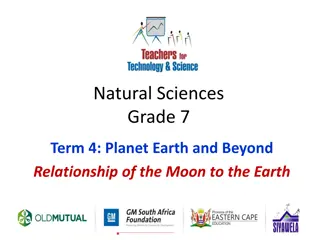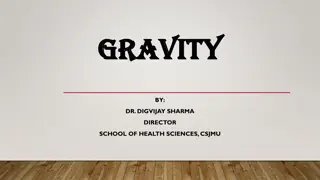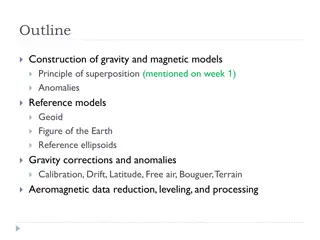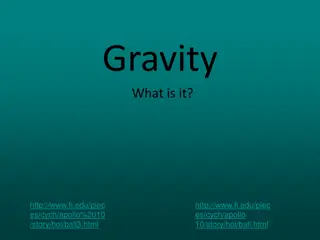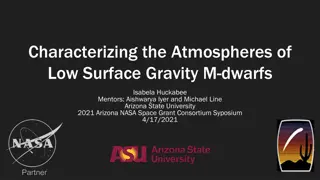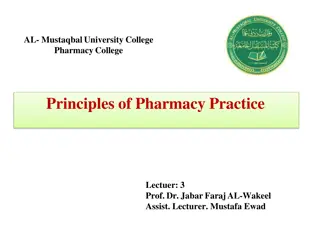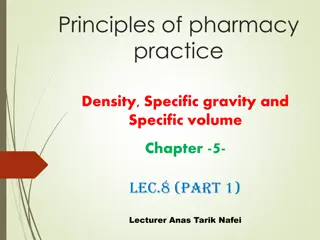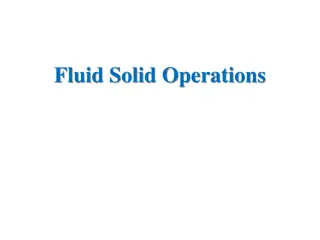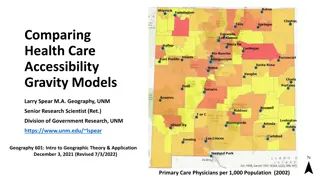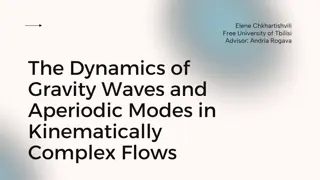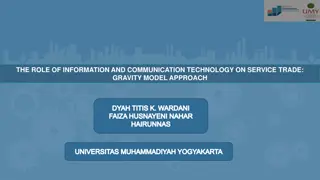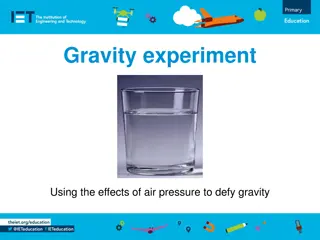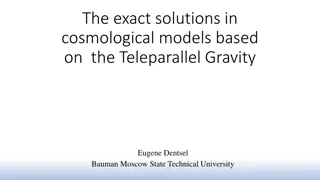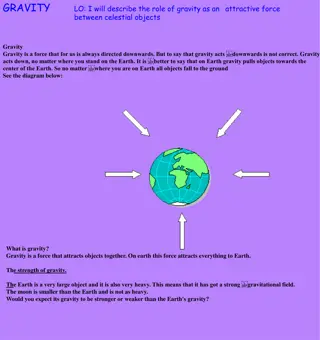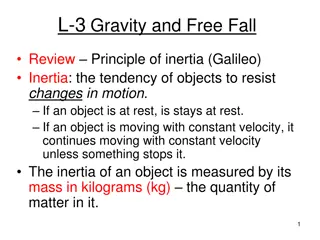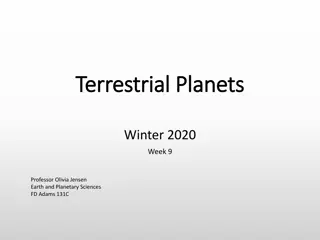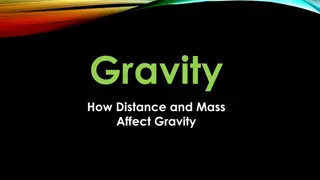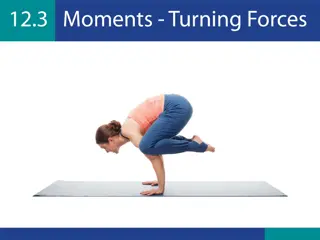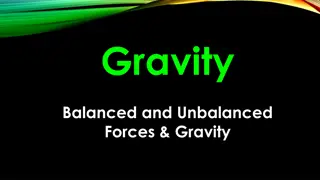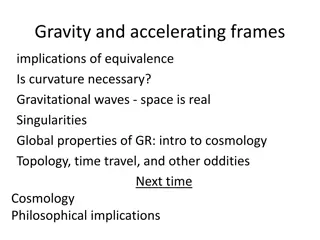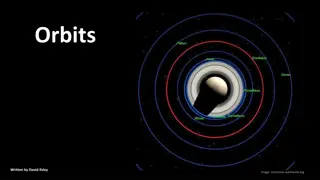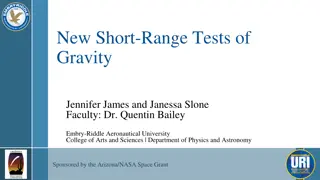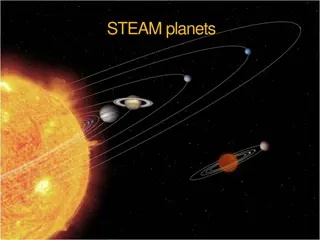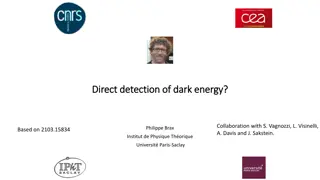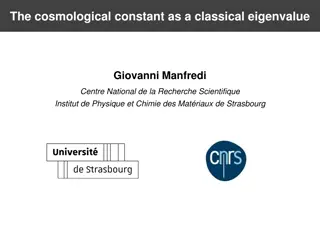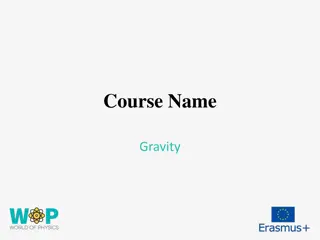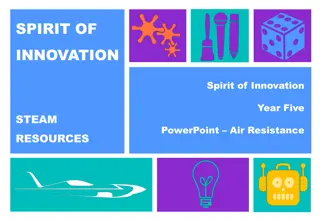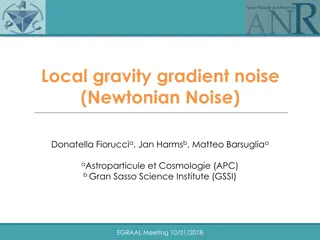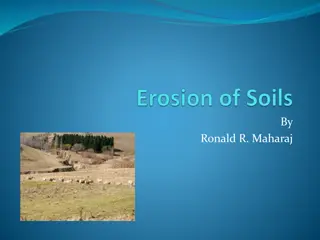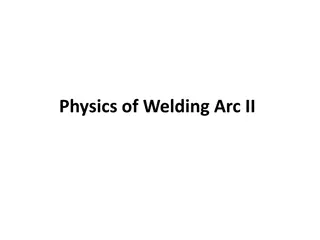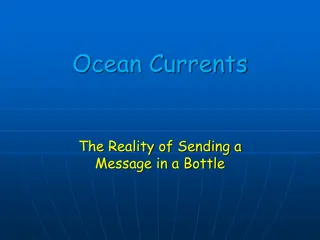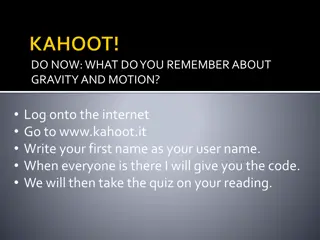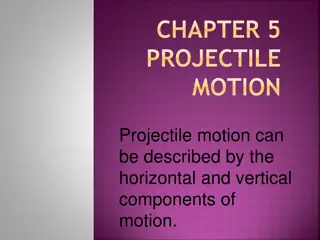Understanding Gravity and its Applications
Explore the fascinating world of gravity through topics like the law of gravity, gravitational force, superposition, and more. Dive into concepts such as net gravitational force, acceleration due to gravity, and gravitational forces in various scenarios. Understand how gravity influences objects in our universe and its significance in physics.
Download Presentation

Please find below an Image/Link to download the presentation.
The content on the website is provided AS IS for your information and personal use only. It may not be sold, licensed, or shared on other websites without obtaining consent from the author. Download presentation by click this link. If you encounter any issues during the download, it is possible that the publisher has removed the file from their server.
E N D
Presentation Transcript
Chapter 13 Gravity
Law of Gravity m Force between them Mm F = G 2 r body Gravitational constant : G = 6.67x10-11 Nm2/Kg2 r M Force on the body by earth is towards the earth (FbE ) Force on the earth is towards the body (FEb ) Earth FbE = -FEb
Gravitation and law of superposition Force on the body 1 due to body 2 and 3 will be the vector sum of the two forces F F F = + F12 12 13 m2 m1 If there are many bodies m3 = + + + F F F F 12 13 1 N
All tie (a) 1, 2 and 4 tie, then 3; (b) line d
T61-Q20. Two uniform concentric spherical shells each of mass M are shown in Fig. 11. The magnitude of the gravitational force exerted by the shells on a point particle of mass m located a distance d from the center, outside the inner shell and inside the outer shell, is: A) GMm/d2 Fig. 11 T61-Q21. Fig. 12 shows five configurations of three particles, two of which have mass m and the other one has mass M. The configuration with the least (minimum) gravitational force on M, due to the other two particles is: A) 2 Fig. 12 T102Q16. Five masses are put together as shown in Figure 8. What is the net force on the 1.0-kg mass placed in the center of the circle? G is the gravitational constant. A)() G/a2 (+j)
T72-Q19: A spaceship is going from the Earth (mass = Me) to the Moon (mass = Mm) along the line joining their centers. At what distance from the centre of the Earth will the net gravitational force on the spaceship be zero? (Assume that Me = 81 Mm and the distance from the centre of the Earth to the center of the Moon is 3.8 105 km). (Ans: 3.4 105 km) T62Q27. Eight balls of different masses are placed along a circle as shown in Fig. 8 The net force on a ninth ball of mass m in the center of the circle is in the direction of: A) NE T52Q#19: Calculate the magnitude and direction of net gravitational force on particle of mass m due to two particles each of mass M, where m =1000 kg and M =10000 kg and are arranged as shown in the Fig. 5. Ans: 4.3 x 10-5 N directed towards negative x-axis
Acceleration Due to gravity (ag) ag = g = 9.8 m/s2 at the surface of the earth
ag at different height above the surface Lets consider the earth as a perfect sphere Earth pulls the ball with force Mm G F Earth pulls the ball with force = (ii ) F ma = ) 1 ( g 2 r From equation (i) and (ii) m Mm h (Km) ag (m/s2 ) Altitude example mag= G h 2 r 0 9.83 Mean Earth Surface M ag= G 8.8 9.80 Mt. Everest 2 r M + = 36.6 9.71 Highest crewed bellon a G g rE 2) ( r h M E 400 8.7 NASA The acceleration due to gravity depends on the distance from the center of the earth 3500 0.225 Communicatio n satellite = = = 8 . 9 = 2 0 / at h r r a g m s E g
But Earth is not a perfect sphere .! Its bulged in the equator requator > rpole M rpole ag= G 2 r requator M More Accurately ag-equator < ag-pole
T32Q21 : The gravitational acceleration at the surface of Earth = 9.8 m/s2. Find the gravitational acceleration at an altitude equal to 3 times the radius of earth. Ans: 0.6 m/s2 T72Q21: At what altitude above the Earth s surface would the gravitational acceleration be ag/4 ? (where ag is the acceleration due to gravitational force at the surface of Earth and Re is the radius of the Earth). (Ans: Re) T92Q22. What would be the weight of a 100-kg man on Jupiter? The mass of Jupiter is equal to 318 times the mass of Earth and the radius is 11 times that of Earth. A) 2.6 x 103 N T101Q15. Find the acceleration due to gravity on a planet whose mass is four times the mass of Earth and whose radius is half the radius of Earth (g is the acceleration due to gravity on Earth). A) 16 g
It spins as well! FN = F F F Gravitational force N g c Mm 2 Fc mv G = mg ma 2 r Centripetal force g r Fg E weight m 2 v = g a g r E Free fall acceleration Gravitational acceleration Centripetal acceleration - = rE M
Mass is also not uniformly distributed in the earth Mantle Outer core core
Gravitation inside the Earth mM = in F G 2 r 4 3 4 r 3) ( m r = = M V 3 r = in in F G 3 2 4 mG 3 = F r r 4 mG 3 = if k M = F kr Like a spring or Pendulum
Work and Potential Energy The net work and potential energy are related by, = W U You can always store energy in the form of potential energy. But for that you need to apply force (Fa) to do work against natural forces such as gravity (Fg) and spring force (Fs). Fa Fg Fa Fs h Energy is capacity to do work. They are interchangeable
Gravitational Potential Energy (U) At r = , U = 0 (reference point) . mM mM r d = = = = ( ) cos( 180 ) W F F d r G d r G m 2 r r r r r = negative U W dr mM U = G r mM F = U U G 0 r Taking body from distance r to infinity mM = U U G 0 r rE U = 0 at infinity M mM U = 0 0 G r In general, Potential at distance r from the center of the earth mM = U G r
Gravitational Potential Energy (U) PE of many bodies Gravitational Force (F) & Potential Energy (U) r12 m1 m2 = W U r13 r23 m3 = F r U Potential is a scalar quantity so simply add all the potentials U = F Gm m Gm m Gm m = + + r 1 3 2 3 1 2 U 12 r 13 r 23 r Can you prove this? If there are more than one body, the total PE is sum of the PE of all possible pairs GMm = F 2 r
Work done by gravity (W) Near earth a baseball moved from point A to G. Find the work done by gravity during the motion. Mm Mm = = = + = W U U U G G ve AB A B r r A B Mm Mm = = = + = 0 W U U U G G BC B C r r B C Mm Mm = = = + = W U U U G G ve CD C D r r C Mm D Mm = = = + = 0 W U U U G G DE D E r r D E Mm Mm = = = + = W U U U G G ve EF E F r r E F Mm Mm = = = + = 0 W U U U G G FG F G r r F G
Do you remember? When the change in KE is zero Wc = -Wa Work done by conservative forces Wg + Ws = -Wa
Work done by External agent (Wa) Near earth a baseball moved from point A to G. Find the work done by and external agent to take it from point A to G. Mm Mm = = = + = + W U U U G G ve aAB B A r r B A Mm Mm = = = + = 0 W U U U G G aBC C B r r C B Mm Mm = = = + = + W U U U G G ve aCD D C r r D Mm C Mm = = = + = 0 W U U U G G aDE E D r r E D Mm Mm = = = + = + W U U U G G ve aEF F E r r F E Mm Mm = = = + = 0 W U U U G G aFG G F r r G F
T101-Q17. Three masses m1 = 2.0 kg, m2 = 5.0 kg, and m3 = 20 kg are placed at the corners of an equilateral triangle of sides 0.50 m. Find the gravitational potential energy of the system of these three particles. A) 2.0 10 8 J T82: Each of the four corners of a square with side a is occupied by a point mass m. There is a fifth mass, also m, at the center of the square. To remove the mass from the center to a point very far away the work that must be done by an external agent is given by: A) +4 2Gm2/a T81-Q19: Three point masses m2 = 1.0 kg, m1 = m3 = 2.0 kg, are aligned on a straight line as shown in Figure 6. Take L = 15 cm and d = 5.0 cm. What is the work needed to move m2 from its original position to a final position a distance d from m3? A) 0
Energy Conservation: Comes back to Earth A body is thrown with initial velocity vireaches maximum height and falls down 0 0 = + E W W a f f E = 0 h + = 0 K K U U m 0 0 i 1 GmM GmM + + = 2 0 0 0 mv + 2 ( ) r h r E E rE M K = 0 at because it stops at maximum height
Escape Velocity: Just reach to infinity and stops It is the minimum speed required to escape from the gravity of the planet E = 0 + = 0 K K U U 0 0 1 GmM h2 + = 2 esc 0 0 ( ) 0 ( ) mv i 2 r E h1 K = 0 at because it stops there and a infinity U = 0 m 2 GM = ( ) Solving equation (i) E v ii esc r E GM m = 2 GM gr ma = E But E E g 2 r E rE M 2 2 gr = 2 ( ) v gr iii = E v esc E esc r E = = 8 . 9 . 6 6= 2 2 37 10 11 2 . / v gr Km s esc E
Energy Conservation: Body moves with final velocity at infinity (after escaping gravity) f E = 0 + = 0 K K U U m 0 0 i 1 1 GmM + = 2 2 0 0 0 mv mv 2 2 E r rE M U = 0 at infinity
Escape velocity of any plant is: Conservation of energy equation for escape velocity is: = 2 v a r esc s p 1 GmM + = 2 esc ( ) 0 mv as = acceleration at the surface of the planet rp = radius of the planet 2 r E GMm mag= Master equation 2 r
Escape Velocity T71-Q22: The gravitational acceleration on the surface of a planet, whose radius is 5000 km, is 4.0 m/s2. The escape speed from the surface of this planet is: (Ans: 6.3 km/s) T81-Q18: The escape velocity of a rocket from the surface of the earth is v1. What is the escape velocity of the same rocket from the surface of a planet whose radius and acceleration due to gravity are each 5 times as those of the earth? A) 5v1 T61-Q28. : The escape velocity of an object of mass 200 kg on a certain planet is 60 km/s. When the object is on the surface of the planet, the gravitational potential energy of the object-planet system is: A) 3.6 x 1011 J T82-Q6: What is the mass of a planet, in units of Earth s mass ME, whose radius is twice the radius of Earth and whose escape speed is twice that of the Earth? A) 8ME T102-Q18. If we assume that a black hole is a planet where the escape velocity is equal to the speed of light (3.00 108 m/s), find the radius of a black hole with a mass equal to that of Earth. A) 8.86 10 3 m
Conservation of Energy T101-Q16. Find the speed in m/s that an object must have on the surface of Earth in order to escape from the gravitational field (pull) of Earth with a speed of 2.00 104 m/s. A) 2.29 104 T92-Q20. A rocket is fired vertically from Earth s surface with an initial speed of 2.0 x 104 m/s. Neglecting air resistance, calculate its speed when it is very far from Earth. A) 1.7 x 104m/s T52-Q#22: A 100-kg rock from outer space is heading directly toward Earth. When the rock is at a distance of (9RE) from the Earth's surface, its speed is 12 km/s. Neglecting the effects of the Earth's atmosphere on the rock, find the speed of the rock just before it hits the surface of Earth. (Ans: 16 km/s) T71Q6: A rocket is launched from the surface of a planet of mass M=1.90 1027 kg and radius R = 7.15 107 m. What minimum initial speed is required if the rocket is to rise to a height of 6R above the surface of the planet? (Neglect the effects of the atmosphere). Ans: 5.51 104 m/s
Orbits and Energy Centripetal Force = Gravitational Force GmM r 2 mv = 2 r 2 mv GmM 2 = 2 r GmM 2 = K r GmM = U r = = 2 2 U K E Mechanical Energy GmM 2 2 GmM GmM GmM GmM 2 = = = + + + = = = E E E K K K U U U r r r r r GmM 2 = E r
Time Period (T) 2 mM mv = G 2 r r M = 2 G v r M = 2r 2 G r r 2 2 T M = 2 G r r 2 4 GM = 2 3 T r
Circular orbit T102-Q20. What speed on the surface of Earth should be given to a satellite to put it in an orbit of radius R = 3RE around the Earth (where RE is the radius of Earth)? A) Sqrt(10GME/6RE) T101-Q19. The potential energy of a satellite-planet system is 3.2 106 J. What is the kinetic energy of the satellite in its orbit? A) +1.6 106 J T92-Q20. A 1000 kg satellite is in a circular orbit of radius = 3Re about the Earth. How much energy is required to transfer this satellite to an orbit of radius = 6Re? A) 5.220 x 10 9J T72-Q20: A 1000 kg satellite is in a circular orbit of radius = 2Re about the Earth. How much energy is required to transfer the satellite to an orbit of radius = 4Re? (Re = radius of Earth = 6.37 106 m, mass of the Earth = 5.98 1024 kg) Ans: 7.8 109 J.
Circular orbit: Time Period T101-Q18. A satellite of mass 125 kg is in a circular orbit of radius 7.00 106 m around a certain planet. If the period of revolution of the satellite is 8.05 103 s, what is its mechanical energy? A) 1.87 109 J T92-Q21. A satellite of mass m moves around a planet (of mass M) in a circular orbit of radius R = 9.400 x 103 km with a period of 2.754 x 104 s. Find the mass M of the planet. A) 6.500 1023 kg T81-Q8. A planet is in a circular orbit around the Sun. Its distance from the Sun is four times the average distance of Earth from the Sun. The period of this planet, in Earth years, is: A) 8 T51-Q20: One of the moons of planet Mars completes one revolution around Mars in 1.26 days. If the distance between Mars and the moon is 23460 km, calculate the mass of Mars. Ans: 6.45 x 1023 kg
Keplers 3-Laws of planets Kepler s I Law: (Law of Orbit) b All planets move in elliptical orbits, with the sun at one focus. -a a F F ea b a = Semi major axis b = semi minor axis e = eccentricity , ea = distance of one of the focal point from the center of the ellipse
Keplers 3-Laws of planets Kepler s II Law: (Law of Areas) A line that connects a planet to the sun sweeps out equal areas in the plane of the planet s orbit in equal time intervals; that is the rate dA/dt at which it sweeps out area A is constant t r r 1 t t = r . A r 2 1 dA d = 2 r 2 dt dt 1r dA= 2 2 dt r 2 ( ) dA mr 2 m r r mvr 2 L = = = = 2 2 dt m m m m r dA L = 2 dt m
Keplers 3-Laws of planets Kepler s III Law: (Law of Periods) The square of period of any planet is proportional to the cube of the semi major axis of the orbit r Circle 2 4 GM a = 2 3 T r Elipse 2 4 GM = 2 3 T a Mechanical Energy : Ellipse Mechanical Energy: Circle GmM 2 GmM 2 T 2 3 = = a E E r a
Keplers laws T102-Q19. The law of areas due to Kepler is equivalent to the law of A) Conservation of angular momentum. B) Conservation of mass. C) Conservation of energy. D) Conservation of linear momentum. E) None of the others. T92-Q19. A small satellite is in an elliptical orbit around Earth as shown in Figure 9. L1 and L2 denote the magnitudes of its angular momentum and K1 and K2 denote its kinetic energy at positions 1 and 2, respectively. Which of the following statements is CORRECT? A) L2 = L1 and K2 > K1 T71-Q 7: Fig. shows a planet traveling in a counterclockwise direction on an elliptical path around a star S located at one focus of the ellipse. The speed of the planet at a point A is vA and at B is vB. The distance AS = rA while the distance BS = rB. The ratio vA/vB is: Ans: (rB/rA)
T-102-ch13 Q16. Five masses are put together as shown in Figure 8. What is the net force on the 1.0-kg mass placed in the center of the circle? G is the gravitational constant. A)() G/a2 (+j) Q17. If, instead of being distributed over the volume of the Earth, the mass of the Earth is distributed inside a thin shell, what would be the radial dependence of the gravitational force on an object outside the Earth? Take r to be the distance to the object from the center of the Earth. A)1/r 2 Q18. If we assume that a black hole is a planet where the escape velocity is equal to the speed of light (3.00 108 m/s), find the radius of a black hole with a mass equal to that of Earth. A) 8.86 10 3 m
T-102-ch13 Q19. The law of areas due to Kepler is equivalent to the law of A) Conservation of angular momentum. B) Conservation of mass. C) Conservation of energy. D) Conservation of linear momentum. E) None of the others. Q20. What speed on the surface of Earth should be given to a satellite to put it in an orbit of radius R = 3RE around the Earth (where RE is the radius of Earth)? Sqrt(10GME/6RE)
T-101-ch13 Q15. Find the acceleration due to gravity on a planet whose mass is four times the mass of Earth and whose radius is half the radius of Earth (g is the acceleration due to gravity on Earth). A) 16 g Q16. Find the speed in m/s that an object must have on the surface of Earth in order to escape from the gravitational field (pull) of Earth with a speed of 2.00 104 m/s. A) 2.29 104 Q17. Three masses m1 = 2.0 kg, m2 = 5.0 kg, and m3 = 20 kg are placed at the corners of an equilateral triangle of sides 0.50 m. Find the gravitational potential energy of the system of these three particles. A) 2.0 10 8 J
T-101-ch13 Q18. A satellite of mass 125 kg is in a circular orbit of radius 7.00 106 m around a certain planet. If the period of revolution of the satellite is 8.05 103 s, what is its mechanical energy? A) 1.87 109 J Q19. The potential energy of a satellite-planet system is 3.2 106 J. What is the kinetic energy of the satellite in its orbit? A) +1.6 106 J
T-92-ch13 Q19. A small satellite is in an elliptical orbit around Earth as shown in Figure 9. L1 and L2 denote the magnitudes of its angular momentum and K1 and K2 denote its kinetic energy at positions 1 and 2, respectively. Which of the following statements is CORRECT? A) L2 = L1 and K2 > K1 Q20. A rocket is fired vertically from Earth s surface with an initial speed of 2.0 x 104 m/s. Neglecting air resistance, calculate its speed when it is very far from Earth. A) 1.7 x 104m/s
T-92-ch13 Q21. Two moons orbit the same planet in circular orbits. Moon A has orbital radius R, and moon B has orbital radius 4R. Moon A takes 20 days to complete one orbit. How long does it take moon B to complete its orbit? A) 160 days Q22. What would be the weight of a 100-kg man on Jupiter? The mass of Jupiter is equal to 318 times the mass of Earth and the radius is 11 times that of Earth. A) 2.6 x 103 N
T-91-ch13 Q19 An astronaut weighs 140 N on the moon s surface. He is in a circular orbit of radius 2Rm around the moon, where Rm = 1.74 103 km is the radius of the moon. Find the gravitational force of the moon on the astronaut on this orbit? A) 35.0 N towards the moon. Q20. A 1000 kg satellite is in a circular orbit of radius = 3Re about the Earth. How much energy is required to transfer this satellite to an orbit of radius = 6Re? A) 5.220 x 10 9J Q21. A satellite of mass m moves around a planet (of mass M) in a circular orbit of radius R = 9.400 x 103 km with a period of 2.754 x 104 s. Find the mass M of the planet. A) 6.500 1023 kg
T-91-ch13 Q22. A rocket of mass m is launched from the surface of a planet of mass M = 5.93 1027 kg and radius R = 6.75 103 km. What minimum initial speed is required if the rocket is to rise to a height of 4R above the surface of the planet? (Neglect the effects of the atmosphere). A) 3.10 105 m/s Q23. Two particles A and B of masses mA = 5.2 kg and mB = 2.4 kg are placed on a horizontal frictionless surface a distance d = 4.0 m apart. How much work is required by an external agent to triple (three times) the separation between the particles? A) 1.4 10 10J
T-82-ch13 Q5. Each of the four corners of a square with side a is occupied by a point mass m. There is a fifth mass, also m, at the center of the square. To remove the mass from the center to a point very far away the work that must be done by an external agent is given by: A) +4 2Gm2/a Q6. What is the mass of a planet, in units of Earth s mass ME, whose radius is twice the radius of Earth and whose escape speed is twice that of the Earth? A) 8 ME Q7. A spherical shell has inner radius R1, outer radius R2, and mass M, distributed uniformly throughout the shell. The magnitude of the gravitational force exerted on the shell by a point particle of mass m, located a distance d from the center (d < R1) is: A) 0 Q8. A planet is in a circular orbit around the Sun. Its distance from the Sun is four times the average distance of Earth from the Sun. The period of this planet, in Earth years, is: A) 8
T-81-ch13 Q18. The escape velocity of a rocket from the surface of the earth is v1. What is the escape velocity of the same rocket from the surface of a planet whose radius and acceleration due to gravity are each 5 times as those of the earth? A) 5 v1 Q19. Three point masses m2 = 1.0 kg, m1 = m3 = 2.0 kg, are aligned on a straight line as shown in Figure 6. Take L = 15 cm and d = 5.0 cm. What is the work needed to move m2 from its original position to a final position a distance d from m3? A) 0 Q20. What is the net gravitational force, in Newtons, on mass m5 = 500 kg located at the center of the square as shown in Figure 7. The masses on the corners are m1= m4= 200 kg, m2 = 300 kg and m3 = 100 kg. A) 5.34 x 10 5 towards m2
T-81-ch13 Q21. Two satellites are revolving around the earth. The first satellite has a mass m1 = 2M and potential energy U1 = U, while the second one has a mass m2 = 3M and potential energy U2 = 3 U. The ratio of their orbital radii R1/R2 is A) 2.0 Q22. In 1957 the Russians put the first satellite in orbit. The Americans were able to measure the period and orbital speed of the satellite but could not determine its mass and, therefore, were not able to know the power of the Russian rocket that put the satellite in orbit. The power of the rocket is a measure of the military power of a country because powerful rockets can be used to carry massive bombs. The Americans were not able to determine the mass of the orbiting Russian satellite because: A) The period of revolution of a satellite is independent of its mass. B) The Americans did not have the technology to find the mass of the satellite. C) The Russians put a device in the satellite that prevented others from finding its mass. D) The Russian satellite was sending signals that interfered with the measurements. E) The mass of the satellite was too small to be measured from far away.


